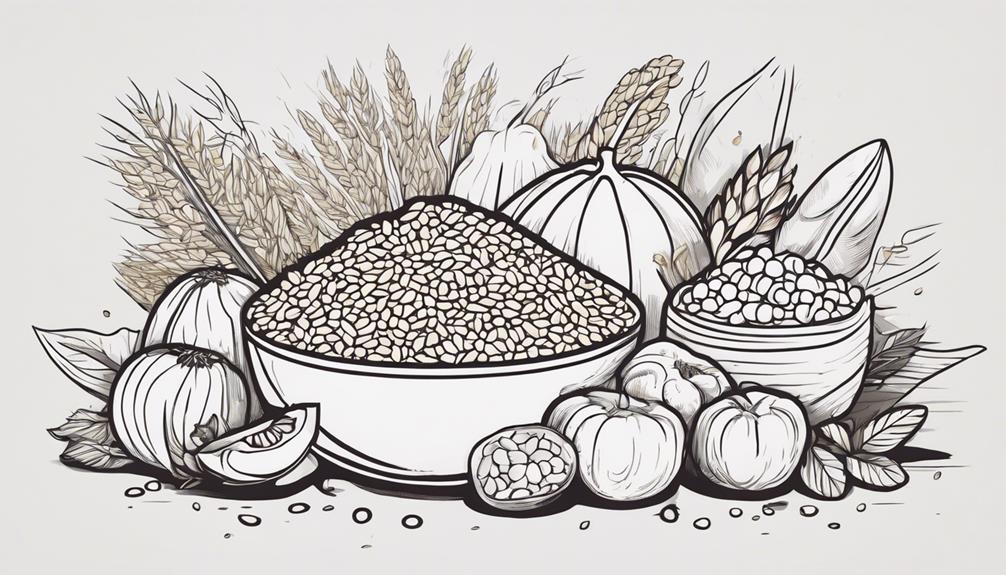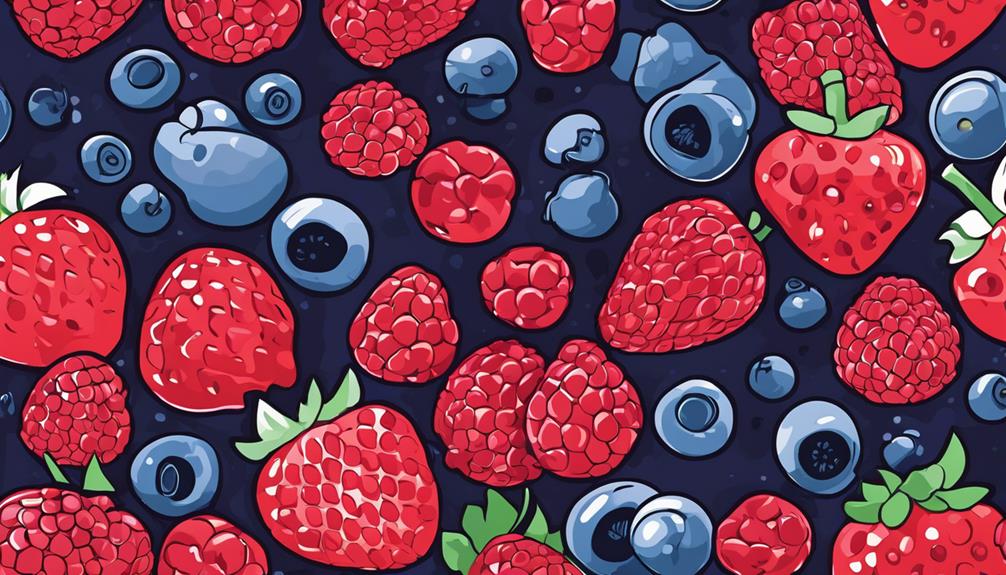When it comes to managing diabetes and keeping your blood sugar levels in check, you've probably heard that 'you are what you eat.' But have you ever wondered which foods can truly make a difference in your health?
The top 7 foods for diabetes management and blood sugar regulation might surprise you. From whole grains to leafy greens, these dietary choices could be the key to a healthier future.
Stay tuned to discover how simple adjustments to your diet can have a significant impact on your well-being.
Key Takeaways
- Whole grains and low glycemic index foods stabilize blood sugar and offer essential nutrients.
- Leafy greens and fiber-rich foods prevent spikes in blood sugar levels and enhance overall health.
- Antioxidant-rich foods like berries improve insulin sensitivity and fight oxidative stress effectively.
- Fatty fish, nuts/seeds, Greek yogurt, and legumes are vital for managing diabetes and supporting stable blood sugar levels.
Whole Grains

When managing diabetes and blood sugar levels, incorporating whole grains into your diet can help stabilize your glucose levels and provide essential nutrients. Whole grains are rich in fiber, which aids in slowing down the absorption of sugar into your bloodstream, helping to prevent spikes in blood sugar levels. They also offer a variety of grain alternatives to traditional refined grains, such as brown rice, quinoa, and whole wheat bread. These alternatives are higher in fiber and nutrients, making them a healthier choice for managing diabetes.
Carb control is crucial for individuals with diabetes, and whole grains can play a significant role in this aspect. By choosing whole grains over refined grains, you can better regulate your carbohydrate intake and prevent sudden blood sugar fluctuations. Whole grains are also packed with essential vitamins and minerals like B vitamins, iron, and magnesium, which are beneficial for overall health. Incorporating whole grains into your diet can be a simple yet effective way to improve your blood sugar management and overall well-being.
Leafy Greens
Incorporating leafy greens into your diet can be a beneficial choice for managing diabetes and blood sugar levels due to their nutrient-rich profile and potential health benefits. Leafy greens are a nutrient powerhouse, packed with essential vitamins, minerals, and antioxidants. They're low in calories and carbohydrates, making them an excellent choice for those looking to regulate blood sugar levels effectively.
One of the key advantages of leafy greens is their meal versatility. You can easily incorporate them into various dishes, such as salads, smoothies, stir-fries, and soups. Adding leafy greens to your meals not only enhances the nutritional value but also helps in controlling blood sugar spikes after eating.
Some popular leafy greens include spinach, kale, arugula, and Swiss chard. These greens aren't only delicious but also offer a wide range of health benefits beyond diabetes management. By making leafy greens a regular part of your diet, you can take a significant step towards improving your overall health and well-being.
Berries

Berries are a great choice for managing diabetes because they're rich in antioxidants, have a low glycemic index, and are packed with fiber, promoting feelings of fullness.
These fruits can help support your overall health and blood sugar levels due to their powerful antioxidant properties.
Including a variety of berries in your diet can be a delicious way to help manage diabetes and improve your well-being.
Antioxidant-Rich Diabetes Support
Boost your diabetes management with the antioxidant power of berries. Berries aren't only delicious but also packed with nutrients that can support your health. Here are some reasons why you should include berries in your diet:
- Antioxidant Benefits: Berries are rich in antioxidants that help fight off free radicals in the body, reducing oxidative stress and inflammation.
- Diabetes Prevention: The antioxidants in berries have been linked to a reduced risk of developing diabetes by improving insulin sensitivity.
- Blood Sugar Control: Berries have a low glycemic index, meaning they've a minimal impact on blood sugar levels.
- Antioxidant Power: The vibrant colors of berries indicate high levels of antioxidants like anthocyanins, which have been shown to benefit overall health.
- Nutrient Density: Berries are a good source of vitamins, minerals, and fiber, making them a nutritious choice for managing diabetes.
Low Glycemic Index
To better manage your diabetes and blood sugar levels, consider incorporating berries into your diet due to their low glycemic index. Berries have a low glycemic load, meaning they've a smaller impact on your blood sugar levels compared to high-glycemic foods.
This makes them an excellent choice for maintaining stable blood glucose levels throughout the day, especially when consumed at appropriate meal timing. Since berries are rich in antioxidants and essential nutrients, they not only help in managing blood sugar but also provide numerous health benefits.
Including a variety of berries such as strawberries, blueberries, and raspberries in your meals can add a delicious touch to your diet while supporting your diabetes management efforts.
Fiber for Satiety
Incorporating fiber-rich berries into your meals can help promote satiety and assist in managing your blood sugar levels effectively. Berries aren't only delicious but also packed with fiber, offering various benefits for individuals looking to control their blood sugar levels.
Here's how including berries in your diet can support your diabetes management through fiber benefits and portion control:
- Fiber Benefits: Berries are rich in soluble fiber, which slows down digestion and helps prevent blood sugar spikes.
- Satiety: The fiber content in berries helps you feel full for longer periods, reducing the likelihood of overeating.
- Portion Control: Snacking on berries can be a satisfying and low-calorie option to manage portions throughout the day.
- Blood Sugar Regulation: The natural sugars in berries are balanced by the fiber content, aiding in better blood sugar control.
- Nutrient Density: Berries are nutrient powerhouses, providing essential vitamins and antioxidants while being low in calories.
Fatty Fish

Fatty fish like salmon, mackerel, and sardines are rich in omega-3 fatty acids, which have been shown to have numerous health benefits, including reducing inflammation and improving heart health. These fish are also an excellent source of high-quality protein, which can help you feel full and satisfied while managing your blood sugar levels effectively.
Including fatty fish in your diet regularly can be a smart choice for maintaining a healthy diet and supporting your overall well-being.
Omega-3 Benefits
Including fatty fish in your diet provides significant benefits due to its rich source of Omega-3 fatty acids, known for their positive effects on managing diabetes and blood sugar levels. Omega-3 benefits include:
- Improved Blood Pressure: Omega-3 fatty acids in fatty fish can help lower blood pressure levels.
- Reduced Inflammation: These acids have anti-inflammatory properties that can benefit those with diabetes.
- Enhanced Insulin Sensitivity: Omega-3s may improve how your body responds to insulin, aiding in blood sugar control.
- Lower Triglyceride Levels: Consuming fatty fish rich in Omega-3 can help reduce triglycerides, a risk factor for heart disease.
- Heart Health: The consumption of Omega-3 fatty acids is linked to a lower risk of heart disease, benefiting overall cardiovascular health.
Protein Source
Diversifying your protein sources to include fatty fish can be beneficial for managing diabetes and blood sugar levels. Fatty fish like salmon, mackerel, and sardines are rich in omega-3 fatty acids, which have been shown to reduce inflammation, improve heart health, and enhance insulin sensitivity. These fish are a great alternative to plant-based proteins and lean meats for individuals looking to control their blood sugar levels.
The high-quality protein content in fatty fish can help you feel full and satisfied, reducing the likelihood of overeating or snacking on unhealthy foods. By incorporating fatty fish into your diet regularly, you can support your overall health while effectively managing diabetes and blood sugar levels.
Nuts and Seeds
Incorporate a variety of nuts and seeds into your diet to help manage diabetes and stabilize blood sugar levels effectively. Nuts and seeds are excellent choices for nutrient-dense snacks that can aid in blood sugar control. Here are five reasons why they should be a part of your diabetes management plan:
- Rich in Healthy Fats: Nuts and seeds contain heart-healthy fats that can improve insulin sensitivity and help regulate blood sugar levels.
- High in Fiber: The fiber content in nuts and seeds slows down the absorption of sugar, preventing spikes in blood glucose after meals.
- Packed with Protein: Protein is essential for balancing blood sugar levels, and nuts and seeds are a great plant-based source of this nutrient.
- Loaded with Essential Nutrients: Nuts and seeds are packed with vitamins, minerals, and antioxidants that support overall health and diabetes management.
- Versatile Snack Options: With a wide variety of nuts and seeds available, you can easily incorporate them into your meals, snacks, or even as toppings for salads and yogurt bowls.
Adding nuts and seeds to your diet can be a simple and delicious way to support your blood sugar goals.
Greek Yogurt

Opt for Greek yogurt as a nutritious addition to your diabetes management plan due to its high protein content and probiotic benefits. Greek yogurt benefits individuals with diabetes by providing a good source of protein that can help manage blood sugar levels. Protein helps increase satiety, reducing the likelihood of overeating and stabilizing blood sugar throughout the day.
Moreover, the probiotics found in Greek yogurt can support gut health, potentially improving insulin sensitivity and reducing inflammation, both crucial factors in diabetes management.
Incorporating Greek yogurt into your diet isn't only beneficial but also delicious. You can enjoy it as a standalone snack or enhance its flavor by adding fresh berries, nuts, or a drizzle of honey. For a creamy and satisfying breakfast option, try mixing Greek yogurt with granola and sliced fruits.
Additionally, Greek yogurt can be used in smoothies, salad dressings, or even as a substitute for sour cream in various recipes. Experiment with different combinations to find tasty recipes that suit your preferences while supporting your diabetes management goals.
Legumes
For managing diabetes effectively, consider including legumes in your diet as they offer numerous health benefits and are rich in essential nutrients. Legumes are a diverse group of plant-based foods that include beans, lentils, chickpeas, and peas.
Here are some reasons why you should incorporate legumes into your meals:
- Rich in Fiber: Legumes are high in soluble fiber, which can help regulate blood sugar levels and improve overall digestive health.
- Low Glycemic Index: Due to their complex carbohydrates, legumes have a low glycemic index, making them a great choice for managing blood sugar levels.
- Plant-Based Protein: Legumes are an excellent source of plant-based protein, which can help with muscle repair and satiety.
- Heart Health: Consuming legumes regularly can lower cholesterol levels and reduce the risk of heart disease.
- Versatile Cooking: Legumes can be used in a variety of dishes, from soups and stews to salads and dips, providing endless meal possibilities.
Incorporating different legume varieties into your meal planning can add nutritional value and help in managing diabetes effectively. Experiment with various cooking methods to enjoy the benefits of legumes in your diet.
Frequently Asked Questions
Are There Any Specific Cooking Methods That Should Be Avoided When Preparing These Diabetes-Friendly Foods?
When preparing diabetes-friendly foods, avoid frying as it can increase unhealthy fats. Opt for steaming, which retains nutrients. This method helps manage blood sugar levels effectively. Choose healthier cooking techniques to support your diabetes management journey.
How Often Should Someone With Diabetes Incorporate These Foods Into Their Daily Diet?
To keep blood sugar steady, weave these foods like a skilled chef – sprinkle them throughout your day's menu. Aim for consistent consumption, spreading their goodness across meals and snacks. Find your rhythm.
Can These Foods Help With Weight Management in Addition to Managing Blood Sugar Levels?
Incorporating the top foods for managing diabetes can aid weight management by promoting nutritional balance. These foods help regulate blood sugar levels and provide essential nutrients, supporting overall health and wellness goals.
Are There Any Potential Side Effects or Interactions With Medications That Individuals With Diabetes Should Be Aware of When Consuming These Foods?
When managing diabetes, it's crucial to stay informed about potential interactions and medication side effects from certain foods. Always consult with your healthcare provider to ensure your diet aligns with your treatment plan.
Are There Any Recommended Portion Sizes for Each of These Foods to Help Maintain Stable Blood Sugar Levels Throughout the Day?
For stable blood sugar levels, focus on portion control, meal timing, and understanding the glycemic index and carb counting. Tailoring the amount of each food to your needs helps maintain balance throughout the day and promotes better diabetes management.
Conclusion
In conclusion, incorporating whole grains, leafy greens, berries, fatty fish, nuts, and seeds into your diet can help manage diabetes and blood sugar levels.
Remember, 'you are what you eat,' so choose wisely to take control of your health.
By making small changes to your diet and focusing on these nutrient-rich foods, you can improve your overall well-being and keep your blood sugar in check.
Stay mindful and make healthy choices for a better tomorrow.